numos
Hazard to Others
  
Posts: 269
Registered: 22-2-2014
Location: Pasadena
Member Is Offline
Mood: No Mood
|
|
Copper Cyanurate > mystery compound?
Ok... So I saw this substance mentioned in various posts here and there and I think it deserves its own topic.
For those who don't know, this substance can be made by reacting a Copper sulfate solution with an Na-DCCA solution. It quickly forms a dense purple
precipitate which can easily be filtered.
Here is a link to Woelen's site, which is where I found out about it.
http://woelen.homescience.net/science/chem/exps/raw_material...
It is this purple stuff I want to focus on. (image 2)
First off what is it called? I've found various names including copper cyanurate, "Copper (II) ions and dichloroisocyanurate ions", and even "the
mystery compound." Also what would the chemical formula be?
Flame test: (Images f1-f4)
Very interesting - almost progressive, starting out yellow, then transitioning to purple, then to green, before burning away. The pictures below are
in chronological order and are taken in a 15 second period. I smelled chlorine as it was burning, so I'm glad I did this outside.
Solubility:
Does not dissolve in water, haven't tried ethanol, toluene, or chloroform, I'll update when I do
Reactions:
As it's not a very commonly seen substance so I've only been able to find a few reactions:
With acetone - originally was going to do a solubility test, but instead it reacted to form a brown substance, neither the purple or the brown seemed
soluble in acetone.
With HCl - A very rapid reaction, if you are going to do it, let me warn you add the products to each other very slowly. The mixture turns a bright
green and seems to give of chlorine gas. It formed a white precipitate (image 3) which I filtered, and I set out the green solution to dry. You can
see what I believe to be the anhydrous on the left and the hydrate on the right (image 4). An interesting note: I used a stainless steel spatula to
scrape off the dried, green product, it was still slight wet and seemingly reacted to the steel, which now has a copper coating. (image 5) What
happened there?  Notice the brown copper contamination in the hydrate from
reacting with the steel. Notice the brown copper contamination in the hydrate from
reacting with the steel.
What would these two products be?
I haven't had time to try these but apparently copper cyanurate (I'm going to call it that until I know its name) also reacts with acetic acid, and
hydrogen peroxide.
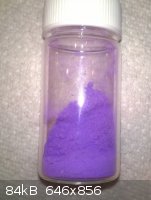  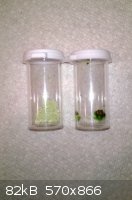 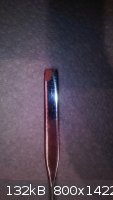
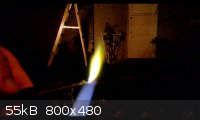 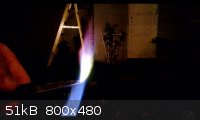 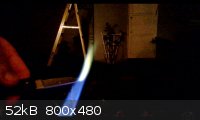 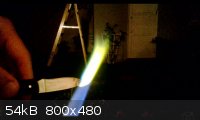
[Edited on 3-14-2014 by numos]
|
|
|
thesmug
Hazard to Others
  
Posts: 370
Registered: 17-1-2014
Location: Chicago, Il (USA)
Member Is Offline
Mood: No Mood
|
|
Some sort of coordination complex?
|
|
|
HeYBrO
Hazard to Others
  
Posts: 289
Registered: 6-12-2013
Location: 'straya
Member Is Offline
Mood: 
|
|
The HCl, being the stronger acid, i presume protonates the salt and you get cyanuric acid ( the white solid ) and Copper chloride xH2O. I know that
Copper chloride tarnishes SS. Try heating the Copper chloride to the anhydride, which is brown. Have you taken a melting point of the white
substance? The chlorine i think would be from unreacted Na-DCCA in the precipitate (did you wash your product?) I get the green but the rest is
unknown to me. (probably to do with its structure)
|
|
|
Nicodem
Super Moderator
      
Posts: 4230
Registered: 28-12-2004
Member Is Offline
Mood: No Mood
|
|
Quote: Originally posted by numos  | | Ok... So I saw this substance mentioned in various posts here and there and I think it deserves its own topic. |
You think it deserves its own topic, but you don't think it deserves a proper review of these older posts? I for one would like to read them.
| Quote: | | For those who don't know, this substance can be made by reacting a Copper sulfate solution with an Na-DCCA solution. It quickly forms a dense purple
precipitate which can easily be filtered. |
I may be missing something, but I don't see how this would give you any kind of copper cyanurate? You would need a redox reaction for such a
transformation, yet you mention no strong enough reducing reagents.
| Quote: | | First off what is it called? |
You can only give systematic names to characterized compounds. So, naming it requires either the determination of its molecular and/or crystal
structure, or checking the literature for this particular product.
| Quote: | With acetone - originally was going to do a solubility test, but instead it reacted to form a brown substance, neither the purple or the brown seemed
soluble in acetone.
With HCl - A very rapid reaction, if you are going to do it, let me warn you add the products to each other very slowly. The mixture turns a bright
green and seems to give of chlorine gas. It formed a white precipitate (image 3) which I filtered, and I set out the green solution to dry.
|
You did some interesting characterization tests. However, these reactions are not consistent with any copper(II) cyanurates, but they are consistent
with what one would expect from copper(II) dichlorocyanurates. I would suggest to check the literature for these instead.
You can also do a check for dichlorocyanurate, by first reducing it to the chloride with any suitable reducing reagent (ascorbic acid, NaHSO3, NaNO2,
etc., measure if there is an exotherm), acidify with H2SO4(aq) to precipitate the cyanuric acid, filter, and check the filtrate with AgNO3. A positive
test would be a strong indicator that what you have is not a cyanurate, but a dichlorocyanurate instead.
Edit: The reaction of CuSO4 and sodium dichloroisocyanurate in water is described in US3055889 and is claimed to give Na2[CuL4]
where L is the dichloroisocyanurate ligand: (C3N3O3Cl2)-. Described are also the preparation of
analogous Ca, K, Ba and Li tetrakis(dichloroisocyanuro)cuprates (or whatever they are called). Analogous Cd and Ni coordination compounds are also
reported.
US3115493 describes the preparation of a lead dichloroisocyanurate and this is then used in the preparation of Pb[CuL4].
An analogous potassium nickelate dichloroisocyanuric complex is also known (DOI: 10.1016/0022-1902(64)90014-4).
[Edited on 14/3/2014 by Nicodem]
…there is a human touch of the cultist “believer” in every theorist that he must struggle against as being
unworthy of the scientist. Some of the greatest men of science have publicly repudiated a theory which earlier they hotly defended. In this lies their
scientific temper, not in the scientific defense of the theory. - Weston La Barre (Ghost Dance, 1972)
Read the The ScienceMadness Guidelines!
|
|
|
numos
Hazard to Others
  
Posts: 269
Registered: 22-2-2014
Location: Pasadena
Member Is Offline
Mood: No Mood
|
|
Quote: Originally posted by Nicodem  | Quote: Originally posted by numos  | | Ok... So I saw this substance mentioned in various posts here and there and I think it deserves its own topic. |
You think it deserves its own topic, but you don't think it deserves a proper review of these older posts? I for one would like to read them.
|
This topic mentions the purple substance:
http://www.sciencemadness.org/talk/viewthread.php?tid=20205
These mention Na-DCCA and TCCA but not the purple compound, however I used them to find the preparation of this substance
https://www.sciencemadness.org/whisper/viewthread.php?tid=90...
http://www.sciencemadness.org/talk/viewthread.php?tid=18624
Sorry for not posting it in the original thread, I'm still fairly new here, please forgive me.
So then the purple substance I have is Na2[Cu(C3N3O3Cl2)4]?
HeYBrO: I did a test with the green compound produced. First I heated the dark green one, which I thought was the hydrate, it turned brown black,
under direct flame it gave off a blue green color. The light green which I thought was the anhydrous salt gave off an orange color > sodium flame?
Anyways they are not the same compound! 
The way I set out the green solution to dry was I put it in a HDPE one gallon water jug with the top cut off so I have a 1 by 1 foot drying bin, and I
place this at an angle so the compound collects in one corner.
The light green dried off at the slant, meaning lower solubility? The dark green collected in the corner... interesting way to separate compounds
based on solubility [Both are probably contaminated though]. So the dark green matched the description of copper chloride, but I have no clue what the
light green could be.
Edit: fixed spelling and clarified some phrases
[Edited on 3-15-2014 by numos]
[Edited on 3-15-2014 by numos]
|
|
|
|